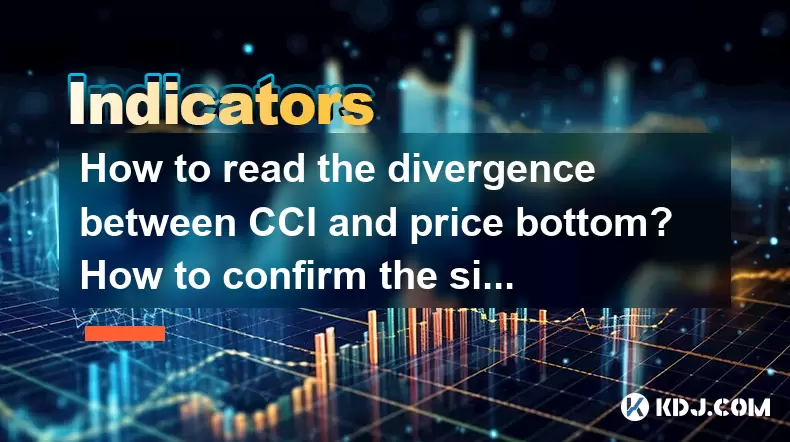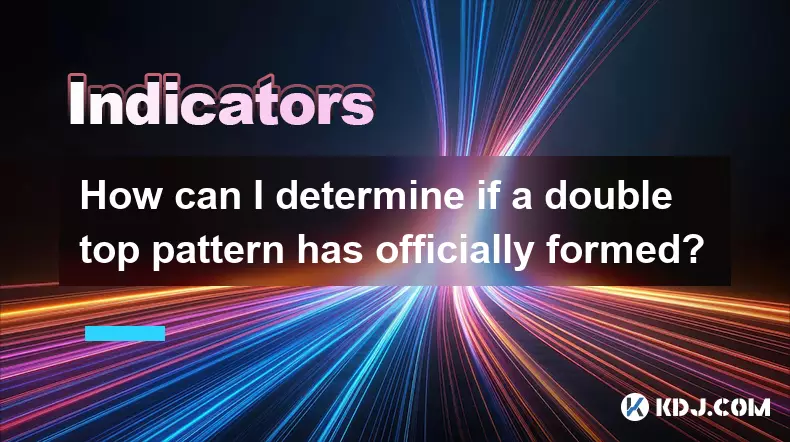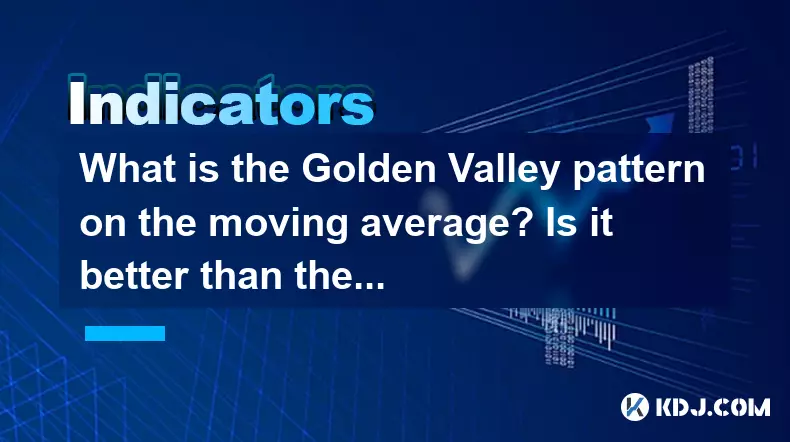-
 bitcoin
bitcoin $109523.663807 USD
-0.13% -
 ethereum
ethereum $4019.526508 USD
2.06% -
 tether
tether $1.000482 USD
0.00% -
 xrp
xrp $2.776815 USD
0.18% -
 bnb
bnb $958.942396 USD
0.12% -
 solana
solana $204.294698 USD
3.84% -
 usd-coin
usd-coin $0.999693 USD
0.00% -
 dogecoin
dogecoin $0.232115 USD
2.09% -
 tron
tron $0.338028 USD
0.84% -
 cardano
cardano $0.790920 USD
1.50% -
 hyperliquid
hyperliquid $44.871443 USD
5.60% -
 ethena-usde
ethena-usde $1.000322 USD
0.04% -
 chainlink
chainlink $21.034165 USD
2.60% -
 avalanche
avalanche $28.794831 USD
-0.54% -
 stellar
stellar $0.360466 USD
1.24%
How to read the divergence between CCI and price bottom? How to confirm the signal of breaking through -100?
CCI divergence signals potential reversals when price forms a lower low but CCI a higher low; breaking above -100 confirms bullish momentum.
Jun 04, 2025 at 04:42 am

Introduction to CCI and Price Divergence
The Commodity Channel Index (CCI) is a versatile indicator used by traders to identify cyclical trends in various markets, including cryptocurrencies. It measures the difference between an asset's price change and its average price change. When analyzing the divergence between CCI and price bottoms, traders can gain insights into potential reversal points. This article will delve into how to read the divergence between CCI and price bottoms and how to confirm the signal of breaking through the -100 level, which is a significant threshold in CCI analysis.
Understanding CCI Divergence and Price Bottoms
Divergence occurs when the price of an asset moves in the opposite direction of a technical indicator, such as the CCI. In the context of price bottoms, a bullish divergence is observed when the price of a cryptocurrency forms a lower low, but the CCI forms a higher low. This discrepancy suggests that the downward momentum is weakening, and a potential reversal to the upside might be imminent.
To read this divergence effectively, traders should:
- Identify the price bottom: Look for a clear low point in the price chart, which should be a part of a downtrend.
- Compare with CCI: Simultaneously, observe the CCI chart to see if the indicator is forming a higher low at the same time the price is making a lower low.
- Confirm the divergence: Ensure that the divergence is significant enough to warrant attention, typically by checking if the CCI has moved away from its previous low by a notable margin.
Confirming the Breakthrough of -100 Level
The -100 level on the CCI is considered a key threshold, often used to identify oversold conditions. When the CCI breaks above this level after being below it, it can signal a potential shift from bearish to bullish momentum. To confirm this signal, traders should follow these steps:
- Monitor the CCI value: Watch the CCI closely as it approaches and crosses the -100 level from below.
- Check for volume increase: Confirm that the breakthrough is supported by an increase in trading volume, as this can validate the strength of the move.
- Look for price confirmation: Ensure that the price also shows signs of reversal, such as breaking above a recent resistance level or forming a bullish candlestick pattern.
Practical Example of CCI Divergence and -100 Breakthrough
Let's consider a practical example using a hypothetical cryptocurrency, CryptoX. Suppose CryptoX has been in a downtrend, and its price has recently formed a lower low at $50. At the same time, the CCI, which had previously reached -150, forms a higher low at -120. This indicates a bullish divergence.
Subsequently, the CCI breaks above the -100 level and reaches -90. To confirm this signal:
- Volume check: The trading volume increases significantly as the CCI breaks above -100.
- Price confirmation: The price of CryptoX breaks above a recent resistance level at $55, forming a bullish engulfing candlestick pattern.
This combination of factors suggests a strong bullish signal, indicating that the downtrend may be reversing.
Using Additional Indicators for Confirmation
While CCI divergence and the breakthrough of the -100 level can provide valuable insights, it is often beneficial to use additional indicators to confirm the signals. Some commonly used indicators include:
- Relative Strength Index (RSI): If the RSI also shows a bullish divergence or moves above its oversold level, it can strengthen the case for a reversal.
- Moving Averages: A crossover of a short-term moving average above a long-term moving average can confirm the bullish momentum.
- MACD (Moving Average Convergence Divergence): A bullish crossover of the MACD line above the signal line can provide further confirmation.
By integrating these indicators, traders can enhance their confidence in the signals generated by the CCI divergence and the -100 breakthrough.
Risk Management and Trading Strategy
When trading based on CCI divergence and the -100 breakthrough, it is crucial to implement effective risk management strategies. Here are some key considerations:
- Set stop-loss orders: Place stop-loss orders below the recent price low to limit potential losses if the expected reversal does not materialize.
- Determine position size: Calculate the appropriate position size based on your overall risk tolerance and the distance to the stop-loss level.
- Take-profit levels: Identify potential take-profit levels based on resistance levels or Fibonacci retracement levels to lock in profits.
By combining these risk management techniques with the insights gained from CCI analysis, traders can improve their chances of successful trades in the cryptocurrency market.
Frequently Asked Questions
Q1: Can CCI divergence be used for short-term trading?A1: Yes, CCI divergence can be effectively used for short-term trading. Traders often look for quick reversals and use shorter time frames to identify and capitalize on these opportunities. However, it is essential to combine CCI divergence with other indicators and risk management strategies to enhance the reliability of short-term signals.
Q2: How often should I check the CCI for divergence and -100 breakthroughs?A2: The frequency of checking the CCI depends on your trading style and time frame. For day traders, checking the CCI every few hours or even every hour can be beneficial. Swing traders might check it daily or weekly. It's important to align the frequency with your trading strategy and the time frame you are most comfortable with.
Q3: Are there any specific cryptocurrencies that work better with CCI divergence analysis?A3: CCI divergence analysis can be applied to any cryptocurrency. However, it tends to work well with cryptocurrencies that have higher liquidity and more significant price movements, such as Bitcoin and Ethereum. These assets often exhibit clearer trends and reversals, making CCI divergence signals more reliable.
Q4: Can CCI divergence be used in conjunction with other types of technical analysis?A4: Yes, CCI divergence can be effectively combined with other types of technical analysis. For instance, chart patterns like head and shoulders, double bottoms, or trend lines can complement CCI divergence signals. Additionally, using fundamental analysis to understand the broader market context can further enhance the reliability of CCI-based trading decisions.
Disclaimer:info@kdj.com
The information provided is not trading advice. kdj.com does not assume any responsibility for any investments made based on the information provided in this article. Cryptocurrencies are highly volatile and it is highly recommended that you invest with caution after thorough research!
If you believe that the content used on this website infringes your copyright, please contact us immediately (info@kdj.com) and we will delete it promptly.
- Rare 1p Coin Could Fetch £200,000: Are You Holding a Fortune?
- 2025-09-27 12:25:13
- MAGACOIN Finance: Buzz, Risks, and the Altcoin Stampede
- 2025-09-27 12:25:13
- Crypto Wallets & Utility Tokens: What's the Hype?
- 2025-09-27 12:30:02
- Shiba Inu's Burn Rate & Crypto Payroll: A New York Perspective
- 2025-09-27 12:45:11
- Grayscale, Near Protocol, and On-Chain Innovation: A New Era for Crypto?
- 2025-09-27 12:45:11
- Punjab Govt, Centre, and the Financial Package: A Tug-of-War?
- 2025-09-27 12:30:02
Related knowledge

What is a tower bottom candlestick pattern? Does it have a high success rate?
Sep 22,2025 at 07:18am
Tower Bottom Candlestick Pattern Explained1. The tower bottom candlestick pattern is a reversal formation that typically appears at the end of a downt...

What is a black hole pattern in the MACD indicator? Is it a cause for concern?
Sep 21,2025 at 06:54pm
Bitcoin's Role in Decentralized Finance1. Bitcoin remains the cornerstone of decentralized finance, serving as a benchmark for value and security acro...

How can I use the psychological line (PSY) to determine market sentiment?
Sep 17,2025 at 02:19pm
Understanding the Psychological Line (PSY) in Cryptocurrency TradingThe Psychological Line, commonly referred to as PSY, is a momentum oscillator used...

How can I determine if a double top pattern has officially formed?
Sep 21,2025 at 03:18am
Understanding the Structure of a Double Top Pattern1. A double top pattern consists of two distinct peaks that reach approximately the same price leve...

What is the Golden Valley pattern on the moving average? Is it better than the Silver Valley pattern?
Sep 21,2025 at 02:54pm
Understanding the Golden Valley Pattern in Moving Averages1. The Golden Valley pattern is a technical formation observed in cryptocurrency price chart...

What does a death cross of the RSI in the strong zone (above 50) mean?
Sep 17,2025 at 10:54pm
Understanding the Death Cross in RSI Context1. The term 'death cross' is traditionally associated with moving averages, where a short-term average cro...

What is a tower bottom candlestick pattern? Does it have a high success rate?
Sep 22,2025 at 07:18am
Tower Bottom Candlestick Pattern Explained1. The tower bottom candlestick pattern is a reversal formation that typically appears at the end of a downt...

What is a black hole pattern in the MACD indicator? Is it a cause for concern?
Sep 21,2025 at 06:54pm
Bitcoin's Role in Decentralized Finance1. Bitcoin remains the cornerstone of decentralized finance, serving as a benchmark for value and security acro...

How can I use the psychological line (PSY) to determine market sentiment?
Sep 17,2025 at 02:19pm
Understanding the Psychological Line (PSY) in Cryptocurrency TradingThe Psychological Line, commonly referred to as PSY, is a momentum oscillator used...

How can I determine if a double top pattern has officially formed?
Sep 21,2025 at 03:18am
Understanding the Structure of a Double Top Pattern1. A double top pattern consists of two distinct peaks that reach approximately the same price leve...

What is the Golden Valley pattern on the moving average? Is it better than the Silver Valley pattern?
Sep 21,2025 at 02:54pm
Understanding the Golden Valley Pattern in Moving Averages1. The Golden Valley pattern is a technical formation observed in cryptocurrency price chart...

What does a death cross of the RSI in the strong zone (above 50) mean?
Sep 17,2025 at 10:54pm
Understanding the Death Cross in RSI Context1. The term 'death cross' is traditionally associated with moving averages, where a short-term average cro...
See all articles










































































